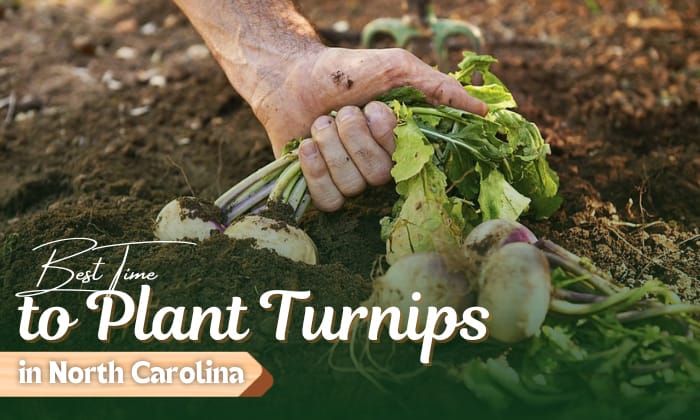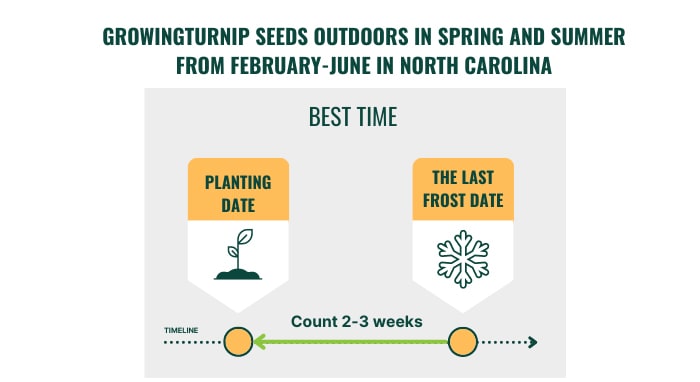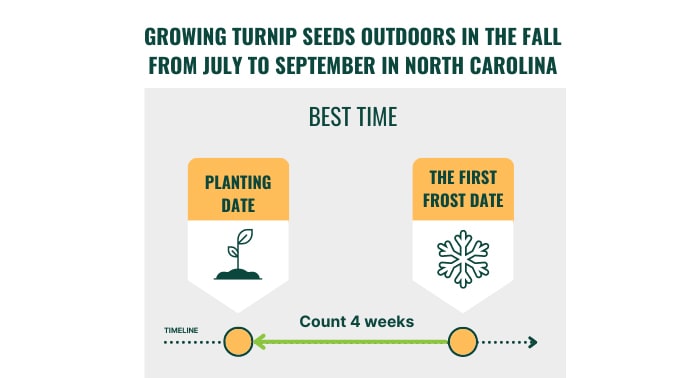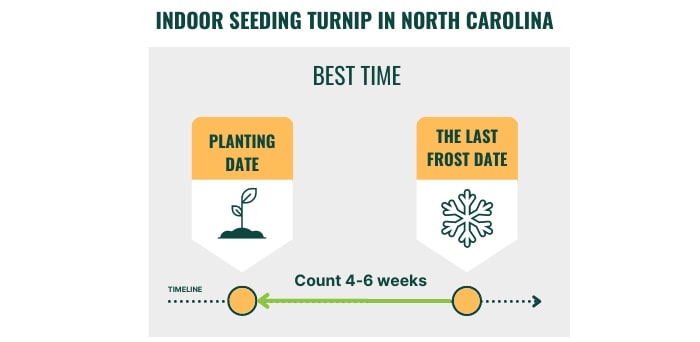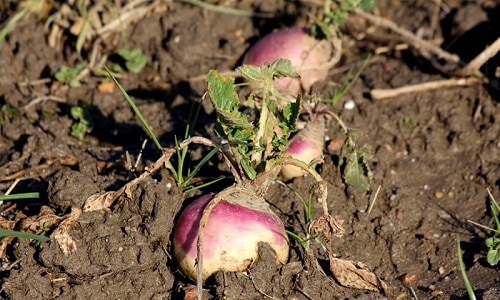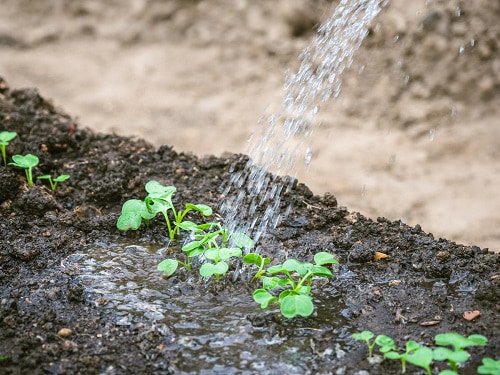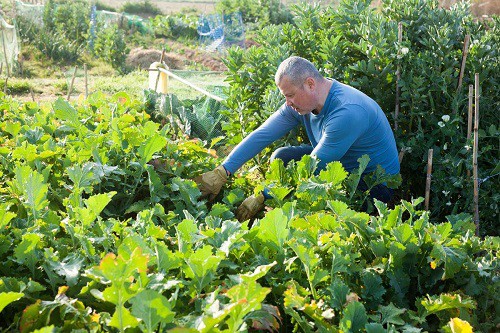As cool-season vegetables that require mild weather to thrive, turnips must be grown in the spring, mid-summer, or fall in NC to develop the best taste.
In practice, February 1 to June 15 and August 1 to September 1 are the ideal planting dates for North Carolina’s Eastern and Piedmont regions.
For western parts of the state, the best gardening periods are March 1 to April 15 and July 15 to August 1 instead.
Read further below for more tips on when to plant turnips in North Carolina.
Table of Contents
Best Time to Plant Turnips in North Carolina
1. Plant turnip seeds outdoors in spring and summer from February to June.
Planting turnips should be done in spring and summer, when the weather is warm but not stifling. In general, you should look up the last frost date of your locality and sow seeds outside two to three weeks before it.
There’s no need to worry about cold weather damaging the turnips, as intermittent frosts won’t hurt them if temperatures don’t fall below 10℉.
Given that North Carolina’s last frost is March 12 to April 30 on average, February 20 to April 9 would make the best dates for planting.
However, turnips growing earlier in February and up to June is possible in Eastern and Piedmont regions of the state, particularly when temperatures reach 40 to 75℉.
2, Plant turnip seeds outdoors in the fall from July to September.
When planting turnips in the fall, you can sow them outdoors four weeks before the first frost if you have a cold frame or tunnel system.
Otherwise, eight weeks before winter frost arrives is a safer option, since this is how long to grow turnips from seeds and have them mature for collecting.
You can expose the harvestable turnips to a mild frost following this schedule, which will allow them to get sweeter for consumption.
If we consider North Carolina’s average first frost of October 13 to November 23, the latest time for planting turnip seeds fall crops would be August 18 to September 28.
3. What about indoor seeding?
You can seed turnips indoors to extend the growing season. However, these veggies are sensitive to transplanting and need compostable pots to experience less root disturbance.
Generally speaking, growing turnips from seeds indoors four to six weeks before the last frost will guarantee higher chances of success. You should also harden the seedlings off for a week and wait until they have two true leaves to move them outside.
4. Planting time for different hardiness zones
Since North Carolina has hardiness zones 5 to 8, we can use their frost dates to estimate turnips’ seeding time.
| Region | Spring seeding (outdoors) | Spring seeding (indoors) | Fall seeding |
| Zone 5 | May 9 | April 18 | August 6 |
| Zone 6 | April 24 | April 3 | August 20 |
| Zone 7 | March 25 | March 4 | September 4 |
| Zone 8 | February 22 | February 1 | September 20 |
5. Planting time for different areas of NC
- Central North Carolina – February 1 to June 15; August 1 to September 1
- Western North Carolina – March 1 to April 15; July 15 to August 1
- Eastern North Carolina – same as Central NC
Turnip Planting Guide for North Carolina
1. Recommended turnip cultivars
| Kinds of turnips for NC | Usage | Description |
| Just Right | Roots and greens | Cold-resistant but tends to bolt early. |
| Purple Top White Globe | Roots and greens | Sweet and mild flavors with big roots (about as large as a baseball) |
| Yellow Globe | Roots and greens | Mild flavors and suitable for storage. Vulnerable against worms. |
| Hakurei | Roots | Hybrid variety that is great for salads with a crisp texture. |
2. Watering and fertilization guidelines
Water turnips with an inch of moisture per week. Do this task daily if there’s no rain to keep the soil moist but not soggy.
As for fertilization, use a balanced N-P-K formula to amend the soil prior to planting. The best fertilizer for turnips is one that’s low in nitrogen, such as a 5-5-5 applied at a rate of two cups per 100 square feet.
Six weeks after turnip shoots appear, you should feed the plant with nitrogen again. Use ¼ cup of a 21-0-0 fertilizer every ten feet to encourage foliar growth.
3. Pest and disease management for turnips
If you have grown cabbage before, you’re probably familiar with the pests and disease of turnips, considering the two plants are similar in this regard. Here is a short turnips planting guide on common problems this crop can have and how to address them.
- Aphids – Ruin leaves and make them look sticky; controllable with insecticidal soap.
- Whiteflies – Kill leaves and secrete a ‘honeydew’ that increases risks of fungal disease. Eliminate with neem oil or sticky traps.
- Clubroot – Cause malformed roots and stunted growth. Prevent this disease by ensuring the soil pH is around 7.2 and using sterile potting soil if growing turnips from seed in containers. It’s also advisable to disinfect gardening tools before using them.
- White rust – Manifest as blisters on leaves and twisted To safeguard plants against white rust, remove garden debris before winter and practice crop rotation. You can grow turnips alongside carrots/parsnips and vegetables like peas and beans.
Frequently Asked Questions
How far apart to plant turnips?
Turnip spacing should be four to six inches apart in rows with at least twelve inches of distance. You can sow the seeds an inch apart if you like, but it’s necessary to thin the shoots down once they have three to four true leaves.
How long do turnips take to grow?
It takes, on average, 55 to 60 days to grow turnips from seeds. The exact timespan depends on the variety you choose.
For instance, if you grow Purple Top turnips, know that Purple Top turnips days to maturity are 50 for the White Globe variety and 60 to 90 days for the forage cultivar (the one that’s meant for deer and livestock).
Yellow Globe turnips, meanwhile, will finish growing in 63 days while White Egg plants require only 48 days.
What are turnip growing stages?
Turnips go through the following stages: germination (which takes four to seven days), first leaves’ development (seven days), seedling (from the second week onwards), and root maturity (lasts up to the 80th day).
In its mature state, the size of a turnip is about two to three inches with a weight of up to six ounces.
Conclusion
When to plant turnips in North Carolina? We hope the answer is apparent by now.
Follow the guidelines above and give your turnips full sun while protecting them from pests with row covers. With appropriate care, you can expect to harvest your turnips in about two months.

Hi, I am William – Floridayards’ digital content creator. My job is to find answers to all your concerns with thorough research and our team’s expert advice. I will also bring you honest reviews on the best products and equipment for raising your beautiful garden. Please look forward to our work!


